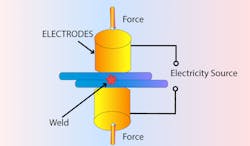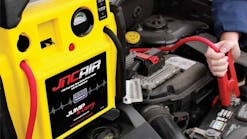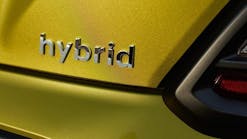Old but effective, these are words that can be used to describe spot welding. This type of welding has been around for some time now. So, what exactly is spot welding, and why is it used in auto body repair works?
Spot welding can be defined as a type of resistance welding that involves the joining of two sheets of metal by applying pressure and heat to the weld area. This method of welding does not require a shielding gas.
So how does it work? Two metals sheets to be joined are placed on top of one another. The two copper alloy electrodes press against the two metal sheets. Electric current is then passed through the two electrodes.
The two sheet metals act as a resistance to the electric current flow, causing heat to be generated. The generated heat then causes the two metals to liquefy and can thus fuse.
Uses in the automotive industry
They no longer make vehicles like they used to. Today automobiles are constructed from lightweight materials. This means materials such as aluminum are increasingly finding their way into cars.
This creates a challenge where these lightweight materials have to be joined to form body structures. And here is where spot welding comes in. When you think about the best welder for aluminum, it is one that can weld the material without burning it through.
Spot welding offers several benefits to the automotive industry. For starters, it is a low-cost method of joining different sheets of metal. Also, it can work with various metals. Thus, can be used for welding aluminum as well as steel sheets.
Titanium, nickel alloys, and stainless steel are some of the metals that spot welding works on. The process also works well on low carbon steel. The welding technique is widely used in the automotive industry for joining thin sheets of metal.
It is estimated that a standard family car can have up to 5,000 spot welds.
Advantages of spot welding
- Spot welding is a low-cost method of welding which makes it ideal for the automotive industry where cost savings are necessary.
- This type of welding does not require a highly skilled welder.
- With spot welding, there is no chance of the materials being distorted or warped.
- The joint that is created from spot welding is highly uniform.
- Spot welding allows for both automatic and semi-automatic welding.
- Spot welding can be achieved in quick succession, which helps improve productivity.
Disadvantages of spot welding
- While it is a low-cost method of welding the initial cost can be high due to the cost of necessary equipment, such as copper alloy electrodes.
- This technique is best suited for thin sheets of metal and may not work well on thick sheets of metal.
- Zinc-coated steels that are commonly used to make vehicle body parts degrade copper alloy electrodes, which can have an impact on productivity.
Materials ideal for spot welding
Vehicle body parts are made from many different types of metals. And not all work well with spot welding. Steel has a high electrical current resistance and is thus one of the best materials for spot welding.
In fact, spot welding has been the preferred method of joining steel sheets in the automotive industry for over 100 years now. Another material that is suited to spot welding is low carbon steel.
However, high carbon steel does not do well with spot welding. Spot welding high carbon steel will result in the material getting fractured. High carbon steel contains more than 0.4wt percent of carbon.
Five tips for spot-welding
- Galvanized or zinc-coated steel requires a higher electric current that ordinary uncoated steel. Thus, when you are working with galvanized steel, it is recommended to use a higher electric current.
- Zinc alloys degrade the copper alloy electrodes used in spot welding. To deal with this problem, you can replace the welding wires frequently. However, copper alloy electrodes are not cheap and frequent replacement may increase the cost of spot welding. One tactic used to address this problem is what is called electrode dressing. This is where a cutter removes the contaminated tip and exposes the clean copper surface.
- Aluminum has a low melting point and a lower resistance compared to steel and copper. Therefore, a higher electric current should be used when spot welding aluminum — ideally, two times more than the electric current you would use on steel of the same thickness.
- Another metal that can be spot-welded is copper. However, as you probably might have guessed, copper electrodes will not suffice here. Electrodes made of alloys with a higher electric current resistance and melting point are used to weld copper.
- Tungsten and molybdenum are the two materials used to make electrodes used in the spot welding of copper. These two have a melting point higher than 1,976 degrees F, which makes them best suited for welding copper.
Information provided by Tool FAQs


